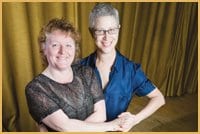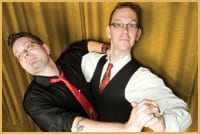
Credit: Sarah Race photo
At the Canadian Legion Hall on Commercial Dr, strains of Gnarls Barkley’s “Crazy” drift into the hallway from the second-floor auditorium. Inside its walls, about a dozen couples shuffle around the scuffed wooden floor, counting their steps and breaking into laughter as they inevitably slip out of rhythm.
From a portrait hung high on the wall, the gaze of Queen Elizabeth II surveys the group. A dance class, yes, but not just any dance class: a same-sex ballroom dance class courtesy of Not So Strictly Ballroom, the only organization offering same-sex dance classes in Vancouver.
Many of the couples in this class are on a mission: to win a medal at this month’s Queer Dance Classic, the first same-sex dancing competition in Western Canada.
Not So Strictly Ballroom (NSSB) began in Vancouver’s East End in 1995, started by a group of lesbians who wanted a chance to dance in a comfortable, non-judgmental environment beyond the strict rules and regulations of the straight dance world.
Gay men soon wanted in on the action, and classes began for them in the West End before NSSB merged the two groups under one umbrella.
The group has grown significantly in the past 12 years, and now offers beginner and intermediate lessons in a variety of styles such as West Coast Swing, Jive and the Waltz, as well as regular social dances.
NSSB isn’t limited to couples or even to gays and lesbians. Everyone is welcome, as long as they are willing to dance with a same-sex partner. Through the world of same-sex dancing, participants (many of whom don’t join in couples) have discovered confidence, athletic skills, and most importantly, the joy of a close-knit, welcoming community.
Pat Hogan, one of the organizers of the Queer Dance Classic, has been involved in Not So Strictly Ballroom since the very beginning. An experienced dancer, she has competed in the Gay Games in Amsterdam and Sydney, as well as attended the World Outgames in Montreal last year.
Traditionally, ballroom dancing has always paired men with women as dance partners, she notes. NSSB emerged to challenge that tradition and give gays and lesbians an opportunity to dance in queer couplings, too.
“People love to dance,” says Hogan. “There’s a lot of people who would love to dance, but want to do it within their own community and be comfortable, and have it be okay.”
Same-sex dancing has exploded in Europe, and is slowly growing in popularity here in Canada. In practice, same-sex dance partners perform much the same styles of dancing as in the straight dance world, except for one important difference: the queer partners continually switch roles.
In straight dances, it’s always the male who leads and the female who follows. In same-sex dancing, both partners can lead and follow throughout the performance, providing excitement and variety for both the dancers and the spectators.
“There’s nothing like it, seeing two men or two women dancing together,” Hogan says.
Talks of having a competition here in Vancouver began about a year ago. Over the years, NSSB had developed a consistent, core group of dancers that were looking to take their dancing to the next level. Since straight ballroom dance competitions prohibited male-male or female-female couples, NSSB decided to create their own competition, the Queer Dance Classic.
Taking place Nov 17 at the Scottish Cultural Centre, the competition is an all-day dance extravaganza involving Newcomer, Bronze, Silver and Gold competitions, as well as a fun, late-evening showcase. Anyone is welcome to register or simply attend to watch the festivities. Participants have already registered from all over BC, Oregon, Washington, New York and California, Hogan notes.
The Queer Dance Classic’s organizers are hoping that this competition will bring a lot more visibility to same-sex dancing.
“There’s never been anything like this here in Vancouver,” says Hogan. “We hope that the community here will come out and support it.”
Murray Schellenberg, an NSSB instructor who is also emceeing the event, hopes that mainstream ballroom dancers will attend as well.
“I’m really excited about the opportunity to expose same-sex dancing to both the gay community and the mainstream ballroom dance community,” he says. “There’s going to be some great dancing.”
Geraldine Goyer began teaching with NSSB when they needed a six-week substitute. That was 11 years ago, and Goyer has been intimately involved with the same-sex dance community ever since.
“It’s a nice core community,” she says. “It’s more to me than just a class, it’s why I’ve stuck around so long. They can’t get rid of me now, they’re like my family.”
For Goyer, same-sex dancing is more open and fluid than regular ballroom dancing.
“The same-sex dance community has no kind of preconceived notions of ballroom dancing,” she says. “It’s a much freer, more open environment.”
Dancers involved with NSSB have not only improved their dancing technique and athletic skills, but they have also found a new community of friendship.
Cathy Hine began dancing three years ago after a friend recommended it. She had never danced before, but had just turned 50 and was looking for something new. What she found was a welcoming social group, fitness and confidence.
“It’s brought energy to my life,” she says.
Hine decided to compete in the Queer Dance Classic to take on a new challenge. She’s never entered a dance competition before, but so far she’s not nervous about it.
“I’m looking forward to meeting dancers from other places, and I’m looking forward to performing,” she says. “I think it’s going to be a fun day.”
Hine’s dance partner, Marla Britton, always wanted to dance and finally took the plunge a few years ago. Britton has an athletic background and assumed that dancing would be easy, but soon realized how challenging the techniques could be. Despite its difficulties, over the past few years Britton has experienced the joy of dancing as well as the camaraderie that NSSB offers.
“It’s a great community,” Britton says. “Everyone was so welcoming.”
Gay Hawley, another Queer Dance Classic organizer, has been dancing for 15 years. Though not a competitive person by nature, she thrives on dance competitions because they allow her to set goals and improve her dancing.
“For me, it’s not about the winning,” says Hawley. “It’s the process.”
Goyer, who is also on the Queer Dance Classic organizing committee, will be acting as an event manager at the competition. She’s excited to see her students perform after all their hard work, and she’s also looking forward to the showcase of highly skilled dancers from all over the West Coast.
“I think people are going to be floored,” she says.

 Why you can trust Xtra
Why you can trust Xtra


